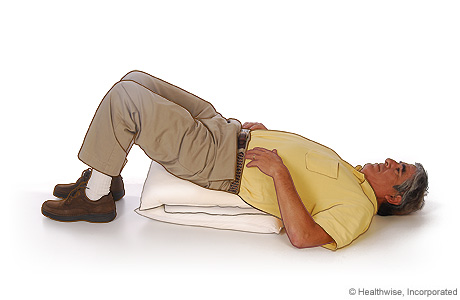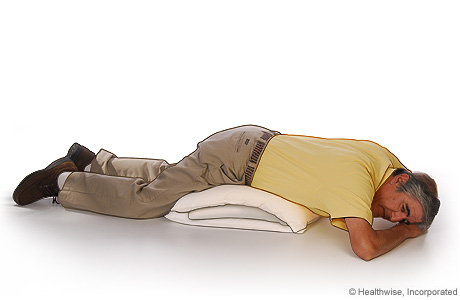Our Health Library information does not replace the advice of a doctor. Please be advised that this information is made available to assist our patients to learn more about their health. Our providers may not see and/or treat all topics found herein.
COPD: Clearing Your Lungs
Overview
When you have too much mucus in your lungs, learning to clear your lungs may help you save energy and improve your breathing. It may also help prevent lung infections.
Here are three ways to clear your lungs:
- Postural drainage
- Chest and back percussion
- Controlled coughing
Ways to clear your lungs
Controlled coughing
Coughing is how your body tries to get rid of mucus. But the kind of coughing you cannot control makes things worse. It causes your airways to close. It also traps the mucus in your lungs.
Controlled coughing loosens mucus and moves it through your airways. It is best to do it after you use your inhaler or other medicine. Follow these steps for controlled coughing.
- Sit on the edge of a chair, and keep both feet on the floor.
- Lean forward a little, and relax.
- Breathe in slowly through your nose, and fold your arms over your belly.
- Hold your breath for 3 to 5 seconds before the exhale.
- As you exhale, lean forward. Push your arms against your belly.
- Cough 2 or 3 times as you exhale with your mouth slightly open.
Make the coughs short and sharp. Push on your belly with your arms as you cough. The first cough brings the mucus through the lung airways. The next coughs bring it up and out.
- Inhale again, but do it slowly and gently through your nose.
Do not take quick or deep breaths through your mouth. It can block the mucus coming out of the lungs. It also can cause uncontrolled coughing.
- Rest, and repeat if you need to.
Postural drainage
Postural drainage means lying down in different positions to help drain mucus from your lungs. You can do it on a bed or the floor. Use pillows to help you with different positions.
Morning is the best time to do postural drainage, because it helps clear mucus that has built up during the night. It may also be done just before bed to decrease nighttime coughing.
Do postural drainage about 30 minutes after you use your inhaler. Make sure you have an empty stomach. If you need to cough, sit up and do controlled coughing.
Hold each position for at least 3 minutes.
Drain the front of your lungs by lying on your back.

Put two pillows under your hips. Make sure your chest is lower than your hips. Use a small pillow under your head if it helps you feel more comfortable. While you rest in this position, do belly breathing:
- Put one hand on your belly and the other on your chest.
- When you breathe in through your nose, push your belly out as far as possible. You should be able to feel the hand on your belly move out, while the hand on your chest should not move.
- When you breathe out through your mouth, you should be able to feel the hand on your belly move in.
Drain the sides of your lungs by lying on your side.

Make sure your chest is lower than your hips. Place two or three pillows under your hips. Use a small pillow under your head if it helps you feel more comfortable. While you rest in this position, do belly breathing.
After you drain one side, turn over and drain the other side.
Drain the back of your lungs by lying on your stomach.

Place two or three pillows under your hips. Kneel over the pillows. Use a small pillow under your head if it helps you feel more comfortable. Place your arms by your head. While you rest in this position, do belly breathing.
Chest percussion
Chest percussion means that you lightly clap your chest and back. The clapping loosens the mucus in your lungs. Follow these steps to do chest percussion.
- Ask your doctor where the best spots are to clap. Avoid your spine and breastbone.
- Cup your hand, and lightly clap your chest and back.
It may be easier to have someone do the clapping for you.
- If you need to cough, sit up and do controlled coughing.
Credits
Current as of: July 31, 2024
Author: Ignite Healthwise, LLC Staff
Clinical Review Board
All Ignite Healthwise, LLC education is reviewed by a team that includes physicians, nurses, advanced practitioners, registered dieticians, and other healthcare professionals.
Current as of: July 31, 2024
Author: Ignite Healthwise, LLC Staff
Clinical Review Board
All Ignite Healthwise, LLC education is reviewed by a team that includes physicians, nurses, advanced practitioners, registered dieticians, and other healthcare professionals.
This information does not replace the advice of a doctor. Ignite Healthwise, LLC disclaims any warranty or liability for your use of this information. Your use of this information means that you agree to the Terms of Use and Privacy Policy. Learn how we develop our content.
To learn more about Ignite Healthwise, LLC, visit webmdignite.com.
© 2024-2025 Ignite Healthwise, LLC.




